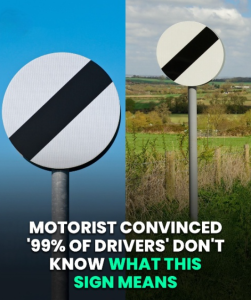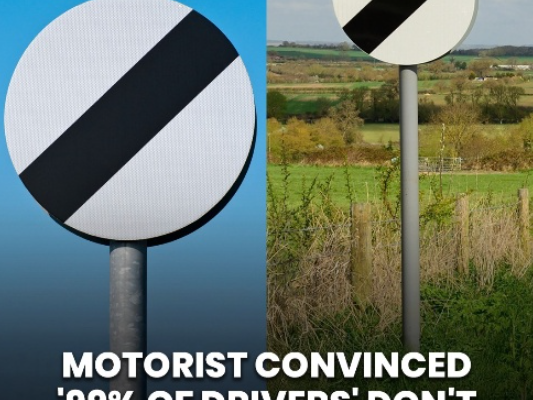
Motorist Convinced ‘99% Of Drivers’ Don’t Know What This Sign Means
Road signs are meant to be clear, simple, and universally understood. They serve as silent instructions, guiding motorists, cyclists, and pedestrians safely along streets and highways. Yet, every now and then, a particular sign will spark confusion, debate, or even outright frustration among road users. That is exactly what happened when one motorist recently claimed that “99% of drivers don’t know what this sign means.” The claim quickly went viral, sparking heated online discussion about whether people truly understand the full range of traffic signs they encounter on the road.
At the center of the conversation is a sign many drivers have seen but few seem to grasp with confidence: the “end of minimum speed limit” sign.
What the Sign Looks Like
The sign in question is a circular symbol with a black diagonal line running across a white background. In many countries, particularly across Europe, this is a familiar marker. However, for those who haven’t brushed up on their driving theory in years, it often triggers uncertainty. Some assume it means “end of speed limit,” others mistake it for “no restrictions,” while a few interpret it as a reminder to “drive carefully.”
In reality, the black diagonal line has a very specific meaning. It signals the end of a particular regulation—for example, the end of a minimum speed requirement on a road, or in some countries, it indicates a return to the national speed limit. The interpretation varies depending on regional road laws, but the core idea is that it marks the conclusion of a specific restriction previously in force.
Why Drivers Get Confused
There are several reasons why even experienced motorists struggle with this sign:
-
Rarely Encountered: Unlike stop signs or pedestrian crossings, which are seen daily, this sign appears in limited contexts such as motorways, country roads, or specific zones. Drivers who spend most of their time in cities may hardly ever see it.
-
Ambiguity in Design: To the untrained eye, the plain diagonal line seems abstract compared to pictorial signs like “children crossing” or “slippery road.” Its minimalism, though designed for clarity, often has the opposite effect.
-
Lapsed Knowledge: Many people study road signs intensively when preparing for their driving test. But once licensed, few return to the highway code. Years later, less common signs fade from memory.
-
Differences Between Countries: A driver trained in one country may misinterpret the same sign elsewhere. For instance, in the UK the sign typically means “national speed limit applies,” while in Germany or France, it can indicate the end of all restrictions or minimum speeds.
The Viral Claim
The motorist who stirred the debate shared a photo of the sign online with the bold assertion:
“I’d bet 99% of drivers on the road right now couldn’t tell me what this means.”
Within hours, thousands of comments flooded in. Some people admitted they had “always guessed,” while others doubled down on incorrect explanations. A few proudly declared they remembered it from their driving test—but their answers often varied depending on where they lived.
One commenter confessed, “I’ve been driving for 20 years and honestly thought it meant drive with caution.” Another added, “I thought it meant no overtaking anymore!”
The sheer diversity of interpretations highlighted the motorist’s point: even seasoned drivers often don’t know what the black diagonal line really signifies.
Why It Matters
At first glance, the debate might seem like a trivial internet squabble. But road safety experts warn that widespread misunderstanding of signs can have real consequences. Misinterpretation can lead to:
-
Unsafe Speeds: If a driver believes the sign cancels all limits, they may accelerate dangerously, risking accidents or fines.
-
Hesitation and Confusion: A driver unsure of the rule might slow down or brake unnecessarily, disrupting traffic flow.
-
Legal Consequences: Misreading the sign doesn’t excuse a driver from penalties. Courts expect licensed drivers to know and follow the highway code.
In short, not knowing a road sign isn’t just embarrassing—it can be dangerous.
A Wider Problem in Driver Knowledge
This incident also shines a light on a broader issue: how little ongoing education there is for drivers after they pass their test. Most people learn once, get licensed, and never study the rules again. Decades later, they may still be relying on partial memories or assumptions.
Driving instructors often note that refresher courses are rare, even though road laws and signage can evolve over time. For example, new environmental zones, electric vehicle lanes, or cycle-priority markings are being added in many cities. Without updated knowledge, drivers risk mistakes.
A survey in the UK a few years ago found that nearly two-thirds of drivers failed to correctly identify lesser-known signs when tested. Similar studies in the U.S. and Australia revealed equally concerning gaps in knowledge.
How to Fix the Problem
Experts suggest several possible solutions to improve road sign awareness:
-
Mandatory Refresher Tests: Just as professional drivers periodically renew certifications, everyday motorists could be required to re-take a short online test every 10 years.
-
Digital Reminders: Governments could integrate highway code quizzes into vehicle registration or insurance renewal processes, subtly encouraging drivers to keep up to date.
-
Public Awareness Campaigns: Viral discussions like this one already highlight the issue. Road safety authorities could seize the moment, releasing educational videos or posts explaining confusing signs.
-
Simplifying Signage: Some argue that if so many people misinterpret a sign, perhaps the design itself is flawed. Adding text beneath symbols in certain areas might prevent mistakes without cluttering the roads.
The Takeaway
The viral claim—that 99% of drivers don’t know the meaning of a specific sign—may be exaggerated, but the discussion it sparked reveals a real truth. Many drivers, even experienced ones, carry gaps in their road sign knowledge. While some mistakes are harmless, others could endanger lives.
The simple black diagonal line may look abstract, but it carries important legal and safety implications. Whether it signals the end of a minimum speed limit or the return to the national speed restriction, knowing its meaning can be the difference between safe driving and risky misjudgments.
For drivers everywhere, the lesson is clear: don’t rely solely on memory from your test years ago. Taking a few minutes to review road signs and rules can boost confidence, prevent fines, and—most importantly—keep everyone safer on the road.
Final Thought
Next time you encounter that mysterious white sign with a black diagonal slash, you’ll know exactly what it means. And if you hear someone say, “99% of drivers don’t know that,” you can smile and reply, “Well, I’m part of the 1% who does.”


